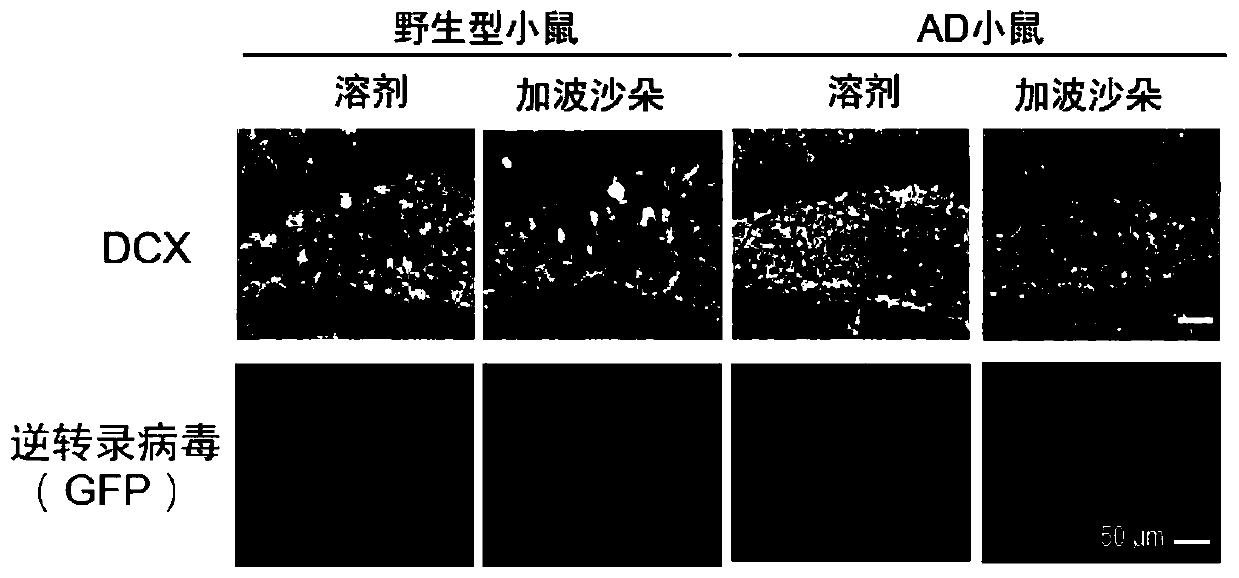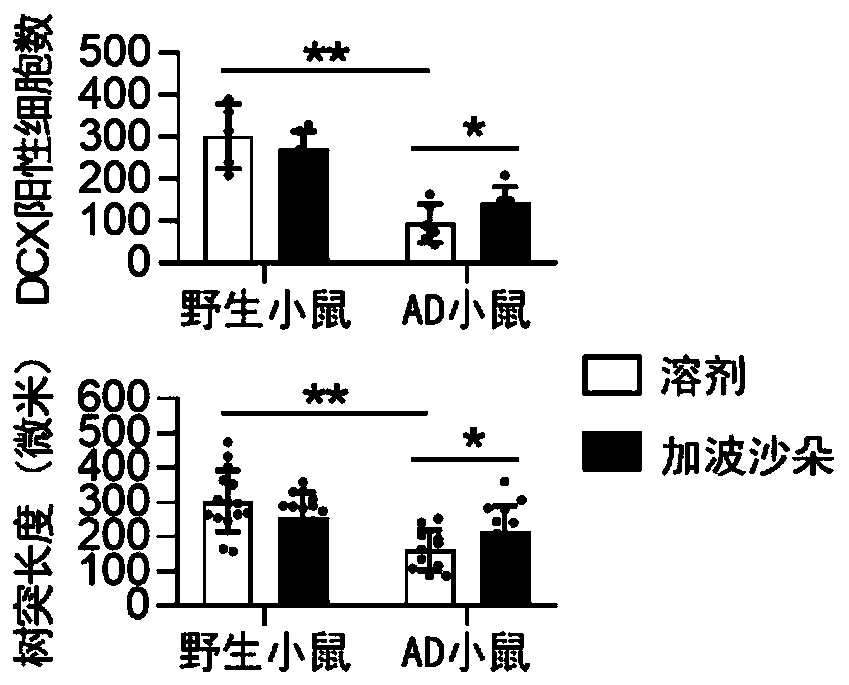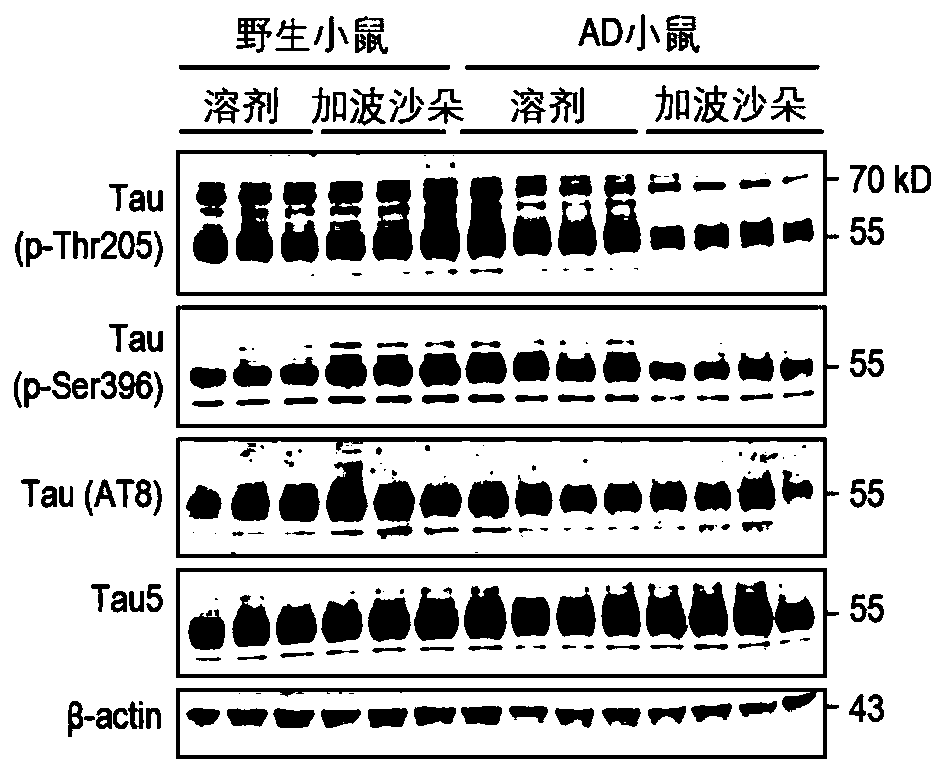Application of gaboxadol to preparation of medicine for treating alzheimer's disease and pharmaceutical composition
A technique for Alzheimer's, gaboxadol, applied in the field of medicinal chemistry
- Summary
- Abstract
- Description
- Claims
- Application Information
AI Technical Summary
Problems solved by technology
Method used
Image
Examples
Embodiment 1
[0020] This example is used to illustrate that gaboxadol can effectively prevent the reduction of hippocampal neuron regeneration in AD mice, and hardly affect the hippocampal neuron regeneration in normal mice.
[0021] Three-transformed AD mice (APP KM670 / 671NL (Swedish), MAPT P301L, PSEN1 M146V) and wild-type mice were used as research objects. Four-month-old 3-transformed AD mice and wild-type mice were selected and injected with retrovirus ROV-GFP in the dentate gyrus of the hippocampus to label newborn neurons. At the same time, solvent (normal saline) or gaboxadol was injected intraperitoneally at 3 mg / kg every 2 days for two months. The brains were collected by perfusion at 6 months old, and the sections were subjected to immunohistochemistry and fluorescent staining to observe the new generation of hippocampal neurons.
[0022] Brain slice preparation includes the following steps:
[0023] A1: Inject 1% pentobarbital sodium (1.5mg / 20g) into the mouse intraperitoneal...
Embodiment 2
[0035] This example is used to illustrate that gaboxadol can effectively reduce hyperphosphorylation and abnormal aggregation of tau protein in the hippocampal dentate gyrus of AD mice, and hardly affect the phosphorylation level of tau protein in normal mice.
[0036] 3-transformed AD mice and wild-type mice were used as research objects. Select 4-month-old wild-type mice and 3-transformed AD mice, and inject solvent (normal saline) or gaboxadol at 3 mg / kg intraperitoneally, every 2 days for two months. At the age of 6 months, the mice were sacrificed acutely, the brain was removed, the hippocampal tissue was separated, and the protein was extracted for Western blot (WB) experiment to detect phosphorylated tau protein (p-Thr205, p-Ser396, AT8) and total tau protein (Tau5).
[0037] 3-transformed AD mice and wild-type mice were used as research objects. Select 4-month-old wild-type mice and 3-transformed AD mice, and inject solvent (normal saline) or gaboxadol at 3 mg / kg intr...
Embodiment 3
[0055] This example is used to illustrate that gaboxadol can effectively improve the learning and memory functions of AD mice without affecting the cognitive functions of normal mice.
[0056] 3-transformed AD mice and wild-type mice were used as research objects. Select 4-month-old wild-type mice and 3-transformed AD mice, and inject solvent (normal saline) or gaboxadol at 3 mg / kg intraperitoneally, every 2 days for two months. Behavioral experiments began at the age of 5 months. For 3 consecutive days before the start of the experiment, the mice were grasped to make them acclimated, and at the same time, the mice were allowed to adapt to the environment of the test box. The object-location recognition experiment is divided into two stages: exploration and testing, such as Figure 5 shown.
[0057] Exploration stage: place the mice in a box (50×50×50cm, with a small green balloon on the inner wall of the box as a visual cue) to explore freely for 5 minutes, in which two id...
PUM
 Login to View More
Login to View More Abstract
Description
Claims
Application Information
 Login to View More
Login to View More - R&D
- Intellectual Property
- Life Sciences
- Materials
- Tech Scout
- Unparalleled Data Quality
- Higher Quality Content
- 60% Fewer Hallucinations
Browse by: Latest US Patents, China's latest patents, Technical Efficacy Thesaurus, Application Domain, Technology Topic, Popular Technical Reports.
© 2025 PatSnap. All rights reserved.Legal|Privacy policy|Modern Slavery Act Transparency Statement|Sitemap|About US| Contact US: help@patsnap.com



